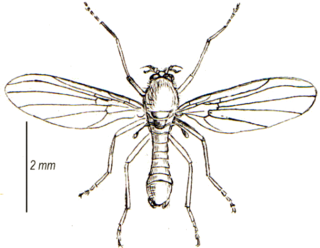
Thaumaleidae, the solitary midges or trickle midges, are a group of nematoceran flies related to the Ceratopogonidae, Chironomidae, and the Simuliidae. They are small, stocky, yellow to brown flies (3–4 mm). Very few species are known for this family. Larvae are found in films on rocks and the nonfeeding adults are usually found on foliage along the same streams in which the larvae are found. A few solitary midges are found in the Southern Hemisphere, but Thaumaleidae are generally an Holarctic family.
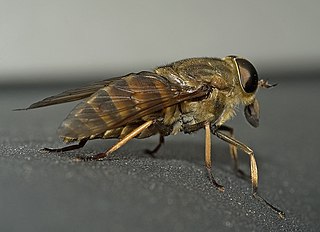
The Brachyceran infraorder Tabanomorpha is a small group that consists primarily of two large families, the Tabanidae and Rhagionidae, and an assortment of very small affiliated families, most of which have been included within the Rhagionidae.

The Brachyceran family Vermileonidae is a small family of uncertain affinities and unusual biology. It includes fewer than 80 described species, most of them rare and with restricted distribution, in 11 genera. Historically the vermileonids had been regarded as belonging to the family Rhagionidae, possibly in a subfamily Vermileoninae. Their biology and morphology are so markedly distinct from the main Rhagionidae sensu stricto however, that the placement as a separate family has been widely accepted.
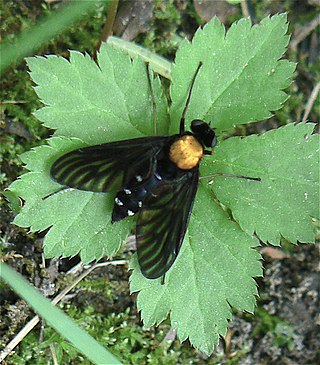
Chrysopilus is common, worldwide genus of predatory snipe flies. There are approximately 300 species in the genus, including fossil members that are sometimes found in amber.

The Lauxaniidae are a family of acalyptrate flies. They generally are small flies with large compound eyes that often are brightly coloured in life, sometimes with characteristic horizontal stripes, such as in Cestrotus species. Many species have variegated patterns on their wings, but in contrast they generally do not have variegated bodies, except for genera such as Cestrotus, whose camouflage mimics lichens or the texture of granitic rocks.

Rhagionidae or snipe flies are a small family of flies. They get their name from the similarity of their often prominent proboscis that looks like the beak of a snipe.
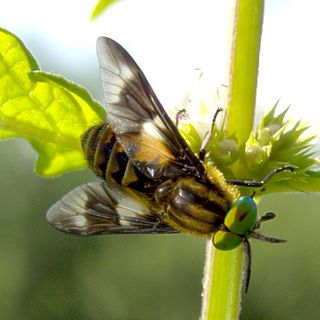
Superfamily Tabanoidea are insects in the order Diptera.

Athericidae is a small family of flies known as water snipe flies or ibis flies. They used to be placed in the family Rhagionidae, but were removed by Stuckenberg in 1973. They are now known to be more closely related to Tabanidae. Species of Athericidae are found worldwide.
Brian Roy Stuckenberg was a South African entomologist who specialised in Diptera.
Oreoleptidae is a family of flies. The family was established in 2005 on the basis of the type species Oreoleptis torrenticola placed in the monotypic genus Oreoleptis. The only known species was collected from the Rocky Mountains where the larvae grow in torrential streams. Larvae have also been found in groundwater wells. The larvae are similar to those of Athericidae and Tabanidae but with long crocheted false-legs (prolegs) arising from abdominal segments 2-7. The larvae have hollow mandibular hooks.
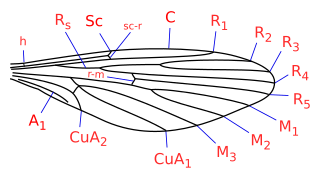
Nemopalpus is a genus of moth fly in the family Psychodidae, in the subfamily Bruchomyiinae. Recently (2018) a number of similar species have been transferred to the genera: Alexanderia, Boreofairchildia, Laurenceomyia and Notofairchildia. In Macquart's original publication, the genus name was spelled both as Nemopalpus and Nemapalpus, but Macquart corrected the error in 1839.
Boreofairchildia is a genus of moth flies in the subfamily Bruchomyiinae. Species have been recorded from the Americas, principally Central and South America, with many, including the type, transferred from the genus Nemopalpus.

Notofairchildia is a genus of moth flies in the subfamily Bruchomyiinae. Species have been recorded principally from South America, with many, including the type, transferred from the genus Nemopalpus.
Laurenceomyia is a genus of moth flies in the subfamily Bruchomyiinae. Species have been recorded principally from south America, with many, including the type, transferred from the genus Nemopalpus.
Namaquamyia is a genus of wormlion in the family Vermileonidae, containing a single species from Namaqualand, Namaquamyia manselli. The genus was first described by Brian Roy Stuckenberg in 2000, who originally named it Namamyia ; this name was preoccupied by the caddisfly genus NamamyiaBanks, 1905, so in 2002 Stuckenberg renamed the genus Namaqualandia.
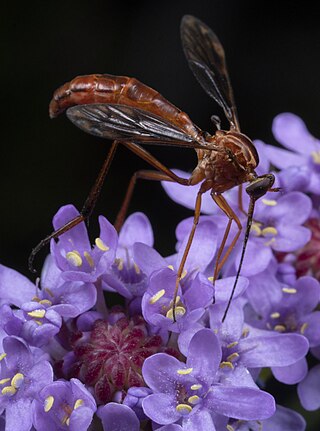
Leptynoma is a genus of wormlions in the family Vermileonidae.
Atrichops is a genus of flies in the family Athericidae.
Pachybates is a genus of flies in the family Athericidae.
Trichacantha is a genus of flies in the family Athericidae.
Xeritha is a genus of flies in the family Athericidae.










